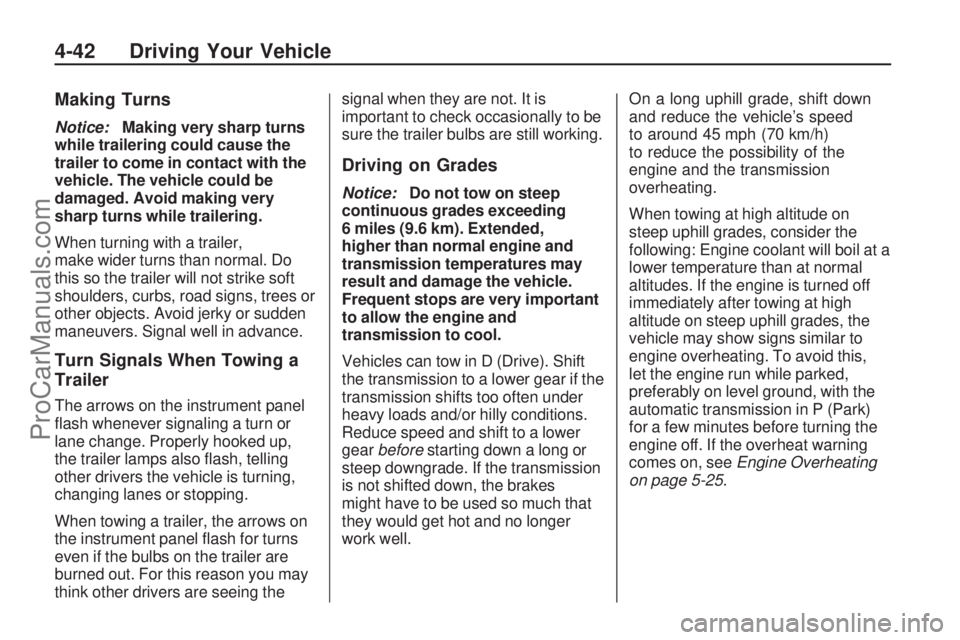turn signal bulb SATURN VUE 2009 Owners Manual
[x] Cancel search | Manufacturer: SATURN, Model Year: 2009, Model line: VUE, Model: SATURN VUE 2009Pages: 386, PDF Size: 2.3 MB
Page 116 of 386

Tilt Wheel
The tilt lever lets the steering wheel
be adjusted.
The tilt lever is located on the left
side of the steering column.
To adjust the steering wheel,
hold the wheel and push the lever
down. Then move the wheel to
a comfortable position and pull the
lever up �rmly to lock the steering
column in place.
Turn Signal/Multifunction
Lever
The lever on the left side of the
steering column includes:
G:Turn and Lane-Change
Signals
3:Headlamp High/Low-Beam
Changer
Flash-to-Pass Feature.
Information for these features is on
the pages following.
Turn and Lane-Change
Signals
An arrow on the instrument panel
cluster �ashes in the direction of
the turn or lane change.
Move the lever all the way up or
down to signal a turn.
Raise or lower the lever until
the arrow starts to �ash and then
release, to signal a lane change.
The turn signal �ashes automatically
three times.
The lever returns to its starting
position whenever it is released.
If after signaling a turn or lane
change the arrow �ashes rapidly or
does not come on, a signal bulb
may be burned out.
3-6 Instrument Panel
ProCarManuals.com
Page 117 of 386

Have the bulbs replaced. If a bulb
is not burned out, check the fuse.
SeeFuses and Circuit Breakers on
page 5-80and for burned-out bulbs.
Headlamp High/
Low-Beam Changer
23
Headlamp High/Low Beam
Changer:Push the turn signal/
multifunction lever away from you
to turn the high beams on.
Pull the lever towards you to return to
low beams.
This indicator light turns on in the
instrument panel cluster when the
high beam headlamps are on.
Flash-to-Pass
This feature lets you use your
high-beam headlamps to signal a
driver in front of you that you want
to pass.
To �ash the high beams from
low beam, pull the turn signal/
multifunction lever all the way
towards you. Then release it.
Windshield Wipers
The windshield wiper lever is
located on the right side of the
steering column.Push up or pull down on the lever
to place it in one of the following
positions.
8(Mist):For a single wiping
cycle. The lever returns to its
starting position when released.
For more cycles, hold the lever
down before releasing it.
9(Off):Turns the wipers off.
&(Intermittent):Sets a delay
between wipes. To set for a shorter
or longer delay between wipes,
move the switch on top of the
lever left or right to decrease
or increase wiper movement.
a(Low):For slow, steady wiping
cycles.
1(High):For rapid wiping cycles.
Clear ice and snow from the
wiper blades before using them.
If the wiper blades are frozen
to the windshield, gently
loosen or thaw them.
Instrument Panel 3-7
ProCarManuals.com
Page 246 of 386

Making Turns
Notice:Making very sharp turns
while trailering could cause the
trailer to come in contact with the
vehicle. The vehicle could be
damaged. Avoid making very
sharp turns while trailering.
When turning with a trailer,
make wider turns than normal. Do
this so the trailer will not strike soft
shoulders, curbs, road signs, trees or
other objects. Avoid jerky or sudden
maneuvers. Signal well in advance.
Turn Signals When Towing a
Trailer
The arrows on the instrument panel
�ash whenever signaling a turn or
lane change. Properly hooked up,
the trailer lamps also �ash, telling
other drivers the vehicle is turning,
changing lanes or stopping.
When towing a trailer, the arrows on
the instrument panel �ash for turns
even if the bulbs on the trailer are
burned out. For this reason you may
think other drivers are seeing thesignal when they are not. It is
important to check occasionally to be
sure the trailer bulbs are still working.
Driving on Grades
Notice:Do not tow on steep
continuous grades exceeding
6 miles (9.6 km). Extended,
higher than normal engine and
transmission temperatures may
result and damage the vehicle.
Frequent stops are very important
to allow the engine and
transmission to cool.
Vehicles can tow in D (Drive). Shift
the transmission to a lower gear if the
transmission shifts too often under
heavy loads and/or hilly conditions.
Reduce speed and shift to a lower
gearbeforestarting down a long or
steep downgrade. If the transmission
is not shifted down, the brakes
might have to be used so much that
they would get hot and no longer
work well.On a long uphill grade, shift down
and reduce the vehicle’s speed
to around 45 mph (70 km/h)
to reduce the possibility of the
engine and the transmission
overheating.
When towing at high altitude on
steep uphill grades, consider the
following: Engine coolant will boil at a
lower temperature than at normal
altitudes. If the engine is turned off
immediately after towing at high
altitude on steep uphill grades, the
vehicle may show signs similar to
engine overheating. To avoid this,
let the engine run while parked,
preferably on level ground, with the
automatic transmission in P (Park)
for a few minutes before turning the
engine off. If the overheat warning
comes on, seeEngine Overheating
on page 5-25.
4-42 Driving Your Vehicle
ProCarManuals.com
Page 249 of 386

Service and
Appearance Care
ServiceService................................5-3
Accessories and
Modi�cations.......................5-3
California Proposition 65
Warning.............................5-4
California Perchlorate
Materials Requirements........5-4
Doing Your Own
Service Work......................5-4
Adding Equipment to the
Outside of the Vehicle...........5-5
FuelFuel....................................5-5
Gasoline Octane...................5-5
Gasoline Speci�cations..........5-6
California Fuel......................5-6
Additives..............................5-6
Fuels in Foreign Countries......5-8
Filling the Tank.....................5-8
Filling a Portable Fuel
Container..........................5-10
Checking Things Under
the Hood
Checking Things Under
the Hood..........................5-10
Hood Release.....................5-11
Engine Compartment
Overview..........................5-12
Engine Oil..........................5-14
Engine Oil Life System.........5-16
Engine Air Cleaner/Filter.......5-17
Automatic Transmission
Fluid................................5-18
Cooling System...................5-19
Engine Coolant...................5-22
Coolant Surge Tank
Pressure Cap....................5-25
Engine Overheating.............5-25
Power Steering Fluid............5-26
Windshield Washer Fluid......5-27
Brakes...............................5-28
Battery...............................5-30
Jump Starting.....................5-31
All-Wheel DriveAll-Wheel Drive...................5-35
Headlamp AimingHeadlamp Aiming................5-36
Bulb ReplacementBulb Replacement...............5-39
Halogen Bulbs....................5-39
Headlamps.........................5-39
Front Turn Signal and
Parking Lamps..................5-40
Taillamps, Turn Signal,
Stoplamps and Back-up
Lamps..............................5-40
License Plate Lamp.............5-41
Replacement Bulbs..............5-41
Windshield Wiper Blade
Replacement
Windshield Wiper Blade
Replacement.....................5-42
TiresTires..................................5-43
Tire Sidewall Labeling..........5-44
Tire Terminology and
De�nitions.........................5-46
In�ation - Tire Pressure........5-49
High-Speed Operation..........5-50
Tire Pressure Monitor
System.............................5-51
Tire Pressure Monitor
Operation..........................5-53
Service and Appearance Care 5-1
ProCarManuals.com
Page 287 of 386

Bulb Replacement
For the proper type of replacement
bulbs, seeReplacement Bulbs
on page 5-41.
For any bulb changing procedure
not listed in this section, contact
your dealer/retailer.
Halogen Bulbs
{CAUTION
Halogen bulbs have pressurized
gas inside and can burst if you
drop or scratch the bulb. You or
others could be injured. Be sure
to read and follow the instructions
on the bulb package.
Headlamps
To replace one of the headlamp
bulbs, use the following procedure.
To replace the parking/turn signal
lamp bulb, seeFront Turn Signal
and Parking Lamps on page 5-40.
1. Open the hood. SeeHood
Release on page 5-11for
more information.
2. Remove the two screws from the
top of the front fascia and grille.
They are inboard of the
headlamp assembly.
3. Remove the three screws
retaining the headlamp assembly.
4. Insert a �at blade tool through the
opening in the top. Make sure the
tool �ts through the opening in the
headlamp bracket lower arm.
5. Push the locking tab toward the
rear of the vehicle with the tool
to lift the headlamp bracket
lower arm.6. Pull back on the front fascia and
then pull the headlamp assembly
out from the vehicle. Another
person might be needed to assist
with this step.
7. Disconnect the electrical
connector from the bulb
assembly.
8. Turn the bulb assembly
counterclockwise to remove it
from the housing.
9. Replace the old bulb with a
new one.
10. Reverse Steps 1 through 8 to
reinstall.
Service and Appearance Care 5-39
ProCarManuals.com
Page 288 of 386

Front Turn Signal and
Parking Lamps
To replace a front turn signal or
parking lamp bulb:
1. Follow Steps 1 through 6 under
Headlamps on page 5-39to
access the front turn signal or
parking lamp.
2. Turn the bulb to be replaced
counterclockwise to remove
it from the headlamp assembly.3. Pull the bulb out of the bulb
socket assembly.
4. Push the new bulb into the bulb
socket assembly.
5. Insert the bulb assembly into the
headlamp assembly.
6. Turn the bulb assembly
clockwise until seated.
7. Reverse the steps to reinstall the
headlamp assembly.
Taillamps, Turn Signal,
Stoplamps and Back-up
Lamps
To replace one of these bulbs:
A. Taillamp/Stoplamp
B. Turn Signal Lamp
C. Back-up Lamp
5-40 Service and Appearance Care
ProCarManuals.com
Page 289 of 386

1. Open the liftgate.
2. Remove the two screws holding
in the taillamp assembly.
3. Slide the taillamp assembly
rearward and away from the
vehicle.
4. Turn the bulb socket being
replaced counterclockwise
to disconnect it.
5. Pull the bulb out of the bulb
socket.
6. Push the new bulb into the bulb
socket.
7. Reverse Steps 2 through 4 to
reinstall the taillamp assembly.License Plate Lamp
To replace one of these bulbs:
1. Remove the two screws holding
each of the license plate lamps
to the fascia.
2. Turn and pull the license plate
lamp forward through the
fascia opening.
3. Turn the bulb socket
counterclockwise and pull the
bulb straight out of the socket.4. Push the new bulb into the bulb
socket and turn it clockwise to
lock it into place.
5. Push and turn the license plate
back through the fascia opening.
6. Reinstall the two screws holding
the license plate lamps to the
fascia.
Replacement Bulbs
Exterior Lamp Bulb
Number
Back-up Lamp 3156
Front Turn
Signal/Parking3157K
Headlamps
High-beam9005 or
HB3
Low-beam/DRL9006 or
HB4
Rear Turn Signal,
Stoplamp and
Taillamp3057
For replacement bulbs not listed
here, contact your dealer/retailer.
Service and Appearance Care 5-41
ProCarManuals.com
Page 376 of 386

Audio System (cont.)
Setting the Clock..............3-65
XM™ Satellite Radio
Antenna System............3-93
Audio System(s)..................3-67
Audio Systems
Radio Reception...............3-92
Theft-Deterrent Feature......3-91
Automatic Climate Control
System...........................3-20
Automatic Door Lock.............. 2-8
Automatic Door Unlock........... 2-8
Automatic Headlamp
System...........................3-13
Automatic Transmission
Fluid...............................5-18
Operation................2-19, 2-22
B
Battery...............................5-30
Electric Power
Management.................3-15
Run-Down Protection.........3-16
Belt Routing, Engine.............6-16
Bluetooth
®..........................3-81
Brake
Emergencies...................... 4-6
Brake Fluid.........................5-28Brakes...............................5-28
Antilock............................. 4-6
Parking...........................2-24
System Warning Light.......3-31
Braking................................ 4-5
Braking in Emergencies.......... 4-6
Break-In, New Vehicle..........2-15
Bulb Replacement................5-41
Fog Lamp ........................3-14
Front Turn Signal and
Parking Lamps..............5-40
Halogen Bulbs..................5-39
Headlamp Aiming..............5-36
Headlamps......................5-39
License Plate Lamps.........5-41
Taillamps, Turn Signal,
Stoplamps and Back-up
Lamps .........................5-40
Buying New Tires.................5-58
C
Calibration..........................3-47
California
Perchlorate Materials
Requirements................. 5-4
California Fuel....................... 5-6
California Proposition 65
Warning............................ 5-4Camera, Rear Vision............2-31
Canadian Owners..................... ii
Capacities and
Speci�cations...................5-86
Carbon Monoxide
Engine Exhaust................2-28
Liftgate............................. 2-9
Winter Driving..................4-25
Care of
Safety Belts.....................5-74
Cargo
Tie Downs .......................2-44
Cargo Cover.......................2-44
Cargo Management System . . . 2-44
CD, MP3 ............................3-75
Center Console Storage........2-42
Chains, Tire........................5-62
Charging System Light..........3-31
Check
Engine Lamp...................3-35
Checking Things Under
the Hood .........................5-10
Chemical Paint Spotting........5-78
Child Restraints
Infants and Young
Children.......................1-26
Lower Anchors and
Tethers for Children.......1-31
i-2 INDEX
ProCarManuals.com